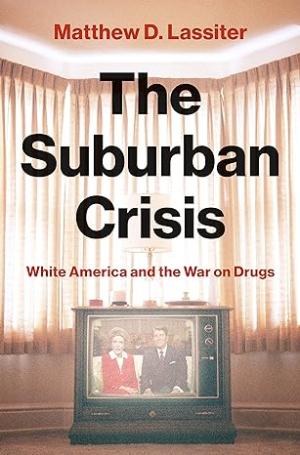The Suburban Crisis: White America and the War on Drugs by Matthew Lassiter (2023, Princeton University Press, 659 pp., $39.95 HB)

But utopia was on the verge of becoming dystopia. A sensationalistic press led by the Los Angeles Times was breathlessly reporting on "wolf packs" of Mexican-American juvenile delinquents accosting the stolid white denizens of suburbia on the one hand and hyping tropes around innocent white teen girls being led down the path to dope and degradation by dark-skinned inner city pushers on the other. The Times' journalism was so lurid and reactionary it was if it were Fox News reporting on crime when Democrats are in power.
And it worked. Spurred by ginned-up fears of the drug- and crime-ridden inner city life leaking into suburbia and those "otherwise law-abiding" (read: white and middle class) youth being seduced into a life of addiction, Southern California parents demanded and politicians passed the nation's first mandatory minimum drug law in 1951. And with that move, they laid the foundations for the modern war on drugs.
This is just the beginning of the story historian and director of the Carceral State Project Matthew Lassiter tells in The Suburban Crisis, his magisterial history of the roots of the drug war. Using a vast array of archival materials, including fascinating troves of letters written to politicians, as well as the records of legislative and congressional hearings, decades of arrest and prosecution data, and the correspondence of various parents' groups, among other sources, Lassiter makes a very persuasive case that protecting our precious white youth has always been central to public policies that have led to the arrest and incarceration of millions while failing to reduce drug use.
He guides the reader not only through legislative histories, both state-level and federal that show decades of bipartisan consensus around ever more repressive drug policy, but also takes great pains to explicate the power of certain imagery and tropes. Among the most powerful and enduring was the "marijuana as a gateway to heroin" trope, endlessly and baselessly repeated by the press and the politicians and given a cherry on top by sordid tales of young white women he started smoking pot and ended up strung out on junk and turning tricks for black pimps. (Never mind, as Lassiter shows, that many of these "victims" actually had very different takes on their experiences and the drug laws from those attempting to use them as political fodder.)
What becomes clear from Lassiter's narrative is the political potency of protecting white youth from drugs and, increasingly, protecting them from serious consequences for their blithe flouting of the drug laws. Once white kids started getting arrested in huge numbers for pot by the mid-1960s, with Southern California leading the way, lawmakers began crafting a response that could punish deserving evil-doers (black or brown pushers, criminal addicts, drug smugglers) while providing deserving innocents (white kids from middle or upper class families) a break for their violations of the criminal law. At every stage of the process, programs were created to divert white pot-smokers out of the criminal justice system, although they typically involved the application of coerced drug treatment or counseling.
In a sense, The Suburban Crisis is the inverse of Michelle Alexander's The New Jim Crow, which argued that drug prohibition was and is a means of controlling and repressing the black population. Lassiter has no bone to pick with Alexander, but his work represents the other half of the story. In it, the centrality of protecting white youth as a basis both for repressive drug laws and for creating escape valves for the deserving becomes crystal clear.
This is a major contribution to the political and social history of America's great crusade. Lassiter provides fine-grained historical detail (such as arrest records for various high schools) as well as a sweeping vision of the "discretionary, discriminatory" enforcement of the drug laws based on "racial and spatial" categories. To understand where we are today and how we got here, you need to read this book.
This work by StoptheDrugWar.org is licensed under Creative Commons Attribution-ShareAlike 4.0 International
Add new comment